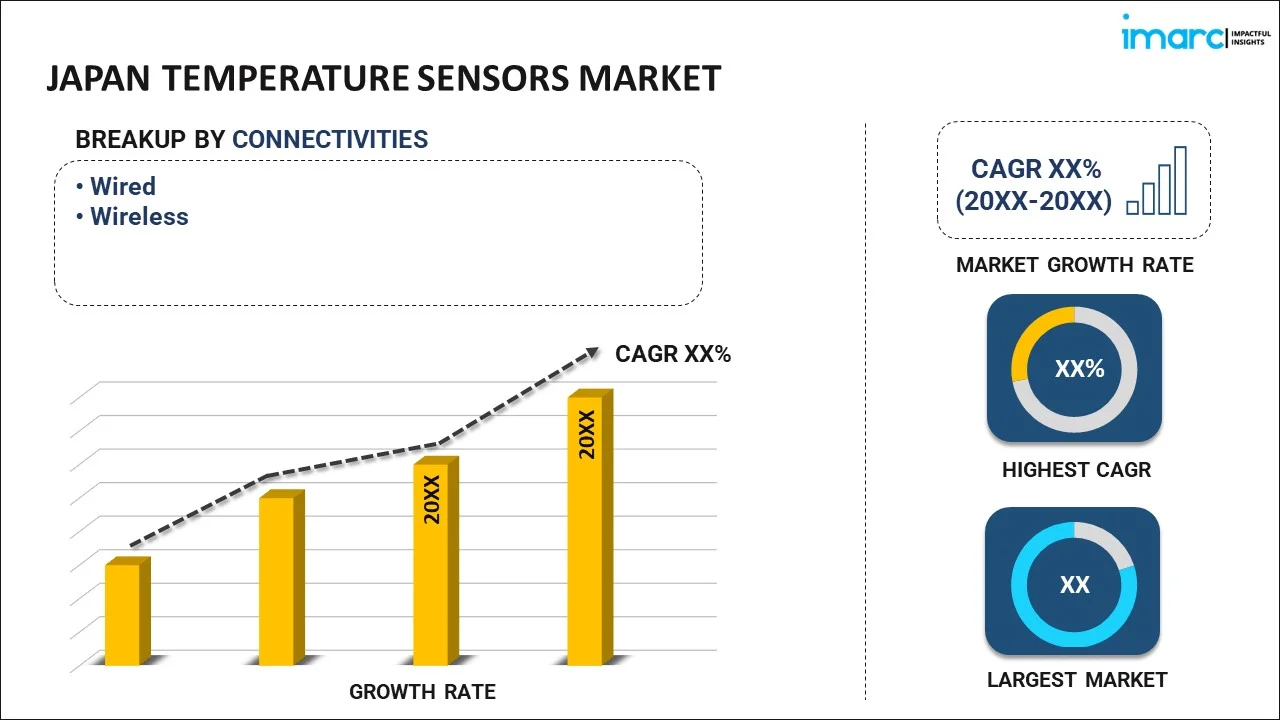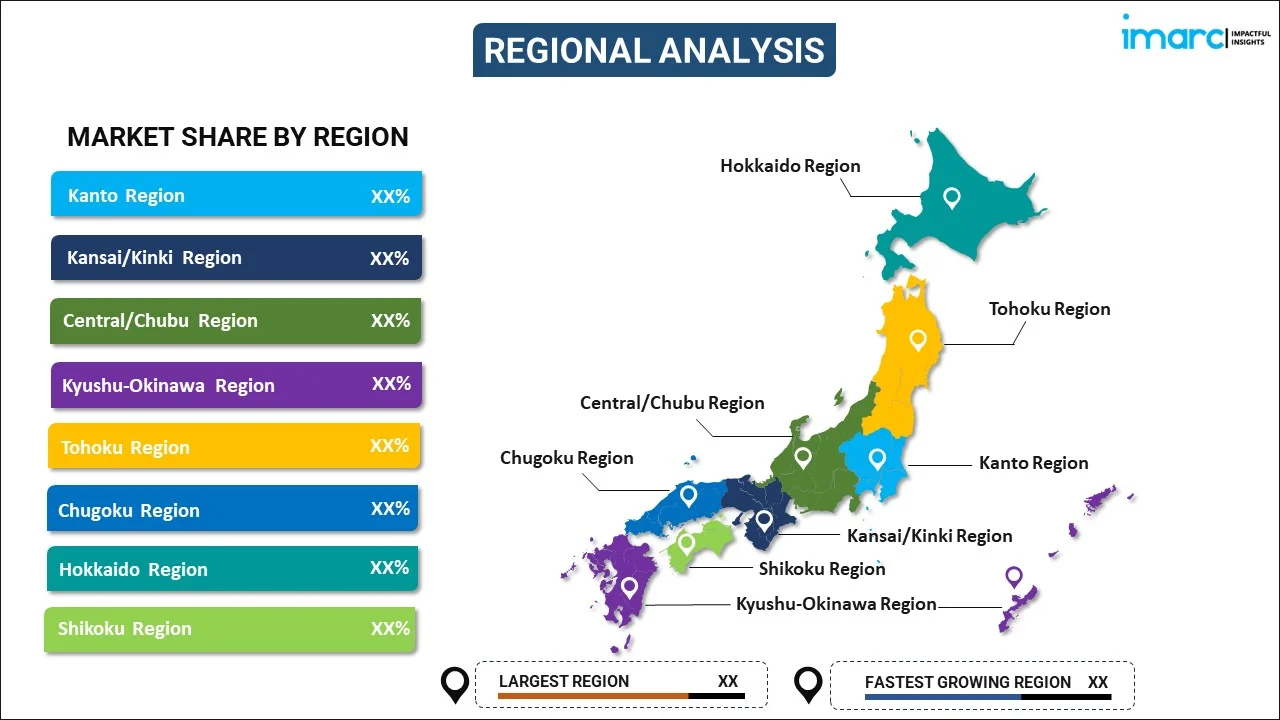
Japan Temperature Sensors Market Report by Connectivity (Wired, Wireless), Technology (Infrared, Thermocouple, Resistance Temperature Detectors (RTD), Thermistor, Temperature Transmitters, Fiber Optic, and Others), End Use Industry (Chemical and Petrochemical, Oil and Gas, Metal and Mining, Power Generation, Food and Beverage, Automotive, Medical, Aerospace and Military, Consumer Electronics, and Others), and Region 2025-2033
Market Overview:
Japan temperature sensors market size reached USD 237.6 Million in 2024. Looking forward, IMARC Group expects the market to reach USD 394.7 Million by 2033, exhibiting a growth rate (CAGR) of 5.3% during 2025-2033. The widespread adoption of automation in various industries such as manufacturing, automotive, and aerospace, which requires precise temperature monitoring for process control and safety, is driving the market.
|
Report Attribute
|
Key Statistics
|
|---|---|
|
Base Year
|
2024 |
|
Forecast Years
|
2025-2033
|
|
Historical Years
|
2019-2024
|
| Market Size in 2024 | USD 237.6 Million |
| Market Forecast in 2033 | USD 394.7 Million |
| Market Growth Rate (2025-2033) | 5.3% |
Temperature sensors are devices designed to measure and monitor temperature variations in various environments. They play a crucial role in a wide range of applications, from industrial processes and scientific research to consumer electronics and climate control systems. Temperature sensors work on the principle that temperature affects certain physical properties of materials, such as electrical resistance, voltage, or the expansion of a liquid. Common types of temperature sensors include thermocouples, resistance temperature detectors (RTDs), and thermistors, each with their own advantages and applications. Thermocouples utilize the voltage generated at the junction of two different metals to determine temperature, making them suitable for high-temperature and rugged environments. RTDs rely on the change in electrical resistance with temperature and offer high accuracy, making them ideal for precise measurements. Thermistors are highly sensitive to temperature changes and are often used in consumer electronics and medical devices. In summary, temperature sensors are invaluable tools for monitoring and controlling temperature in various settings.
Japan Temperature Sensors Market Trends:
The temperature sensors market in Japan is experiencing significant growth, primarily driven by several influential factors. Firstly, the increasing demand for advanced automation across various industries has been a pivotal catalyst, as temperature sensors are crucial for monitoring and controlling processes to ensure efficiency and safety. Additionally, the advent of the Internet of Things (IoT) has opened up new avenues for temperature sensors, connecting devices, and enabling real-time data analysis, which further propels the market forward. Moreover, the stringent regulations and standards pertaining to environmental control in industries such as pharmaceuticals, food and beverage, and automotive necessitate the adoption of precise and reliable temperature sensors, thus boosting the market. Furthermore, the ongoing advancements in technology have resulted in the development of more accurate, durable, and cost-effective sensors, making them more accessible and appealing to a broader range of applications. In conjunction with this, the trend towards miniaturization in electronics, which has facilitated the integration of temperature sensors into various devices, ranging from household appliances to industrial equipment, is expected to drive the temperature sensors market in Japan during the forecast period.
Japan Temperature Sensors Market Segmentation:
IMARC Group provides an analysis of the key trends in each segment of the market, along with forecasts at the country level for 2025-2033. Our report has categorized the market based on connectivity, technology, and end use industry.
Connectivity Insights:

- Wired
- Wireless
The report has provided a detailed breakup and analysis of the market based on the connectivity. This includes wired and wireless.
Technology Insights:
- Infrared
- Thermocouple
- Resistance Temperature Detectors (RTD)
- Thermistor
- Temperature Transmitters
- Fiber Optic
- Others
A detailed breakup and analysis of the market based on the technology have also been provided in the report. This includes infrared, thermocouple, resistance temperature detectors (RTD), thermistor, temperature transmitters, fiber optic, and others.
End Use Industry Insights:
- Chemical and Petrochemical
- Oil and Gas
- Metal and Mining
- Power Generation
- Food and Beverage
- Automotive
- Medical
- Aerospace and Military
- Consumer Electronics
- Others
The report has provided a detailed breakup and analysis of the market based on the end use industry. This includes chemical and petrochemical, oil and gas, metal and mining, power generation, food and beverage, automotive, medical, aerospace and military, consumer electronics, and others.
Regional Insights:

- Kanto Region
- Kansai/Kinki Region
- Central/ Chubu Region
- Kyushu-Okinawa Region
- Tohoku Region
- Chugoku Region
- Hokkaido Region
- Shikoku Region
The report has also provided a comprehensive analysis of all the major regional markets, which include Kanto Region, Kansai/Kinki Region, Central/ Chubu Region, Kyushu-Okinawa Region, Tohoku Region, Chugoku Region, Hokkaido Region, and Shikoku Region.
Competitive Landscape:
The market research report has also provided a comprehensive analysis of the competitive landscape. Competitive analysis such as market structure, key player positioning, top winning strategies, competitive dashboard, and company evaluation quadrant has been covered in the report. Also, detailed profiles of all major companies have been provided.
Japan Temperature Sensors Market Report Coverage:
| Report Features | Details |
|---|---|
| Base Year of the Analysis | 2024 |
| Historical Period | 2019-2024 |
| Forecast Period | 2025-2033 |
| Units | Million USD |
| Scope of the Report | Exploration of Historical Trends and Market Outlook, Industry Catalysts and Challenges, Segment-Wise Historical and Future Market Assessment:
|
| Connectivities Covered | Wired, Wireless |
| Technologies Covered | Infrared, Thermocouple, Resistance Temperature Detectors (RTD), Thermistor, Temperature Transmitters, Fiber Optic, Others |
| End Use Industries Covered | Chemical and Petrochemical, Oil and Gas, Metal and Mining, Power Generation, Food and Beverage, Automotive, Medical, Aerospace and Military, Consumer Electronics, Others |
| Regions Covered | Kanto Region, Kansai/Kinki Region, Central/ Chubu Region, Kyushu-Okinawa Region, Tohoku Region, Chugoku Region, Hokkaido Region, Shikoku Region |
| Customization Scope | 10% Free Customization |
| Post-Sale Analyst Support | 10-12 Weeks |
| Delivery Format | PDF and Excel through Email (We can also provide the editable version of the report in PPT/Word format on special request) |
Key Questions Answered in This Report:
- How has the Japan temperature sensors market performed so far and how will it perform in the coming years?
- What has been the impact of COVID-19 on the Japan temperature sensors market?
- What is the breakup of the Japan temperature sensors market on the basis of connectivity?
- What is the breakup of the Japan temperature sensors market on the basis of technology?
- What is the breakup of the Japan temperature sensors market on the basis of end use industry?
- What are the various stages in the value chain of the Japan temperature sensors market?
- What are the key driving factors and challenges in the Japan temperature sensors?
- What is the structure of the Japan temperature sensors market and who are the key players?
- What is the degree of competition in the Japan temperature sensors market?
Key Benefits for Stakeholders:
- IMARC’s industry report offers a comprehensive quantitative analysis of various market segments, historical and current market trends, market forecasts, and dynamics of the Japan temperature sensors market from 2019-2033.
- The research report provides the latest information on the market drivers, challenges, and opportunities in the Japan temperature sensors market.
- Porter's five forces analysis assist stakeholders in assessing the impact of new entrants, competitive rivalry, supplier power, buyer power, and the threat of substitution. It helps stakeholders to analyze the level of competition within the Japan temperature sensors industry and its attractiveness.
- Competitive landscape allows stakeholders to understand their competitive environment and provides an insight into the current positions of key players in the market.
Need more help?
- Speak to our experienced analysts for insights on the current market scenarios.
- Include additional segments and countries to customize the report as per your requirement.
- Gain an unparalleled competitive advantage in your domain by understanding how to utilize the report and positively impacting your operations and revenue.
- For further assistance, please connect with our analysts.
 Inquire Before Buying
Inquire Before Buying
 Speak to an Analyst
Speak to an Analyst
 Request Brochure
Request Brochure
 Request Customization
Request Customization




.webp)




.webp)












